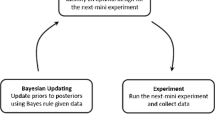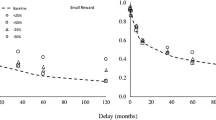Abstract
The present experiment examined temporal discounting across 3 different age bands: adolescents, adults, and older adults (mean ages 14, 46, and 73 years, respectively). A computerized task was employed in which participants were asked to choose between larger rewards available at a specified time in the future—either £100 or £1,000 (approximately $200 and $2,000, respectively)— or a smaller reward available immediately. The subjective value of the reward decreased with increasing delay for each of the 3 age groups. A hyperbola-like function adequately described the group discounting data. The adolescent group discounted significantly more than the adult group when the larger later reward (LLR) was £100 but not when the LLR was £1,000. The adolescents discounted significantly more than the older adult group when the LLR was either £100 or £1,000. There were no significant differences in discounting between the adult and older adult groups. The results of the present study suggest that the rate of temporal discounting is higher in adolescents than in adults but is stable from middle adulthood to older adulthood. Furthermore, the process of temporal discounting appears to be quantitatively similar across the life span.
Similar content being viewed by others
References
BINDER, L. M., DIXON, M. R., & GHEZZI, P. M. (2000). A procedure to teach self-control to children with attention deficit hyperactivity disorder. Journal of Applied Behavior Analysis, 33, 233–237.
CRITCHFIELD, T. S., & KOLLINS, S. H. (2001). Temporal discounting: Basic research and the analysis of socially important behavior. Journal of Applied Behavior Analysis, 34, 101–122.
DIXON, M. R., JACOBS, E. A., & SANDERS, S. (2006). Contextual control of delay discounting by pathological gamblers. Journal of Applied Behavior Analysis, 39, 413–422.
DYMOND, S., REHFELDT, R. A., & SCHENK, J. J. (2005). Nonautomated procedures in derived stimulus relations research: A methodological note. The Psychological Record, 55, 461–482.
FEINGOLD, A. (1994). Gender differences in personality: A meta-analysis. Psychological Bulletin, 116, 429–456.
GREEN, L., FRY, A. F., & MYERSON, J. (1994). Discounting of delayed rewards: A life-span comparison. Psychological Science, 5, 33–36.
GREEN, L., MYERSON, J., & OSTASZEWSKI, P. (1999). Discounting of delayed rewards across the life span: Age differences in individual discounting functions. Behavioural Processes, 46, 89–96.
JOHNSON, W., & BICKEL, W. (2002). Within subjects comparison of real and hypothetical money rewards in delay discounting. Journal of the Experimental Analysis of Behavior, 77, 129–146.
KIRBY, K. N., & MARAKOVIC, N. N. (1995). Modelling myopic decisions: Evidence for hyperbolic delay-discounting within subjects and amounts. Organisational Behavior and Human Decision Processes, 64, 22–30.
MAZUR, J. E. (1987). An adjusting procedure for studying delayed reinforcement. In M. L. Commons, J. E. Mazur, J. A. Nevin, & H. Rachlin (Eds.), Quantitative analyses of behavior: Vol. 5. The effect of delay and of intervening events on reinforcement value (pp. 55–73). Hillsdale, NJ: Erlbaum.
MYERSON, J., & GREEN, L. (1995). Discounting of delayed rewards: Models of individual choice. Journal of Experimental Analysis of Behavior, 64, 263–276.
MYERSON, J., GREEN, L., & WARUSAWITHARANA, M. (2001). Area under the curve as a measure of discounting. Journal of the Experimental Analysis of Behavior, 76, 235–243.
RACHLIN, H. (1989). Judgment, decision, and choice: A cognitive/behavioral synthesis. New York: W. H. Freeman.
RACHLIN, H., & GREEN, L. (1972). Commitment, choice and self-control. Journal of the Experimental Analysis of Behaviour, 17, 15–22.
RICHARDS, J. B., ZHANG, L., MITCHELL, S. H., & DE WIT, H. (1999). Delay or probability discounting in a model of impulsive behaviour: Effect of alcohol. Journal of the Experimental Analysis of Behaviour, 71, 121–143.
ROBERTS, B. W., CASPI, A., & MOFFITT, T. (2001). The kids are alright: Growth and stability in personality development from adolescence to adulthood. Journal of Personality and Social Psychology, 81, 670–683.
Author information
Authors and Affiliations
Corresponding author
Rights and permissions
About this article
Cite this article
Whelan, R., McHugh, L.A. Temporal Discounting of Hypothetical Monetary Rewards by Adolescents, Adults, and Older Adults. Psychol Rec 59, 247–258 (2009). https://doi.org/10.1007/BF03395661
Published:
Issue Date:
DOI: https://doi.org/10.1007/BF03395661




